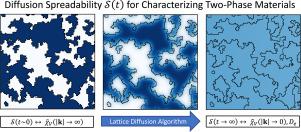Acta Materialia ( IF 8.3 ) Pub Date : 2023-03-17 , DOI: 10.1016/j.actamat.2023.118857 M. Skolnick , S. Torquato

|
Time-dependent diffusion processes between phases of heterogeneous materials are ubiquitous in a variety of contexts in the physical, chemical, and biological sciences. Examples of such materials include composites, porous materials, geological media, cellular solids, polymer blends, colloids, gels, and biological media. The recently developed diffusion spreadability, , provides a direct link between time-dependent interphase diffusive transport and the microstructure of two-phase materials across length scales (Torquato, 2021); thus making a powerful dynamic means for classifying all statistically homogeneous microstructures, spanning from anti-hyperuniform to hyperuniform. It was shown that the small-, intermediate-, and long-time behaviors of are directly determined by the small-, intermediate-, and large-scale structural features of the material. Moreover, the spreadability can be applied as a physical-property based tool for microstructural characterization in the absence of or as supplement to scattering information. In this work, we develop a computationally efficient algorithm for ascertaining directly from digitized representations of material microstructures via random-walk techniques. Our algorithm yields the time-dependent local walker concentration field , a quantity not previously examined in the context of the spreadability, enabling us to compute the entropy production rate of the associated diffusion process, which is a quantity related to the rate of energy dissipation. We also derive exact analytical expressions for , and find that hyperuniform materials have smaller dissipation than any nonhyperuniform materials. Lastly, we use our algorithm to compute, for the first time, the more general case of the spreadability in which the phase diffusion coefficients are distinct and provide a method for extracting the effective diffusion coefficient of the two-phase material from such data. We apply our algorithm to a variety of two- and three-dimensional simulated model (non)hyperuniform microstructures to assess their large-scale structures and diffusion properties. Given previously identified connections between the spreadability and certain nuclear magnetic resonance (NMR) and magnetic resonance imaging (MRI) procedures, our algorithm is also pertinent to such experimental studies. Overall, our algorithm has practical use in the discovery and design of heterogeneous materials with desirable time-dependent diffusion properties.
中文翻译:

用于表征两相材料的结构和传输特性的模拟扩散铺展性
在物理、化学和生物科学的各种环境中,异质材料相之间随时间变化的扩散过程无处不在。此类材料的示例包括复合材料、多孔材料、地质介质、多孔固体、聚合物混合物、胶体、凝胶和生物介质。最近开发的扩散铺展性,, 提供了时间相关的相间扩散传输与跨长度尺度的两相材料微观结构之间的直接联系(Torquato,2021);从而使一种强大的动态方法,用于对从反超均匀到超均匀的所有统计均匀微观结构进行分类。结果表明,小、中、长期行为直接由材料的小型、中型和大型结构特征决定。此外,在没有散射信息或作为散射信息的补充时,可铺展性可用作基于物理特性的微观结构表征工具。在这项工作中,我们开发了一种计算效率高的算法来确定通过随机游走技术直接从材料微观结构的数字化表示。我们的算法产生了时间相关的局部步行者浓度场,一个以前没有在可扩展性的背景下检查过的数量,使我们能够计算熵产生率相关的扩散过程,这是一个与能量耗散率相关的量。我们还推导出精确的解析表达式,并发现超均匀材料比任何非超均匀材料的耗散都小。最后,我们首次使用我们的算法计算了相扩散系数不同的更一般的铺展性情况,并提供了一种从此类数据中提取两相材料有效扩散系数的方法。我们将我们的算法应用于各种二维和三维模拟模型(非)超均匀微结构,以评估它们的大规模结构和扩散特性。鉴于先前确定的可扩展性和某些核磁共振 (NMR) 和磁共振成像 (MRI) 程序之间的联系,我们的算法也与此类实验研究相关。全面的,











































 京公网安备 11010802027423号
京公网安备 11010802027423号